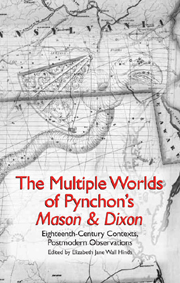 The Multiple Worlds of Pynchon's 'Mason and Dixon'
The Multiple Worlds of Pynchon's 'Mason and Dixon' from The Rounds of History
Published online by Cambridge University Press: 12 September 2012
Happy are those ages when the starry sky is the map of all possible paths — ages whose paths are illuminated by the light of the stars. Everything in such ages is new and yet familiar, full of adventure and yet their own. The world is wide and yet it is like home, for the fire that burns in the soul is of the same essential nature as the stars.
— György Lukács, The Theory of the NovelMaking the Rounds of History
THOMAS PYNCHON'S 1997 Mason & Dixon is a novel obsessed with time. A “postmodern” novel, it reconstructs a historical period, the mid- to late-eighteenth century, with both an accuracy surpassing many bona fide histories and a disregard for the actual past seldom met with in a historical novel. Its play of and with histories, along with its determinedly late-twentieth-century timbre, makes time — and especially its passing — a constant focus. From first to last, from character Charles Mason's melancholia associated with his wife's passing, to the deep and broad concern with calendar reform in the novel, to the very fact of its being an “eighteenth-century” novel, Mason & Dixon layers time periods and temporal themes to produce an uncertainty of reading bordering on vertigo; finally, and from the first page, this constant thrust of time passing sets up a nostalgia that progresses and deepens at the same time the novel mocks the ludicrous idea of nostalgic sentimentality.
To save this book to your Kindle, first ensure [email protected] is added to your Approved Personal Document E-mail List under your Personal Document Settings on the Manage Your Content and Devices page of your Amazon account. Then enter the ‘name’ part of your Kindle email address below. Find out more about saving to your Kindle.
Note you can select to save to either the @free.kindle.com or @kindle.com variations. ‘@free.kindle.com’ emails are free but can only be saved to your device when it is connected to wi-fi. ‘@kindle.com’ emails can be delivered even when you are not connected to wi-fi, but note that service fees apply.
Find out more about the Kindle Personal Document Service.
To save content items to your account, please confirm that you agree to abide by our usage policies. If this is the first time you use this feature, you will be asked to authorise Cambridge Core to connect with your account. Find out more about saving content to Dropbox.
To save content items to your account, please confirm that you agree to abide by our usage policies. If this is the first time you use this feature, you will be asked to authorise Cambridge Core to connect with your account. Find out more about saving content to Google Drive.